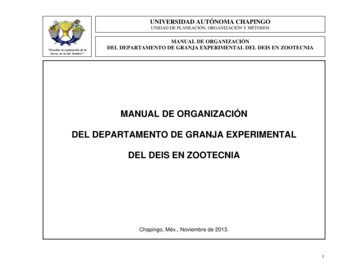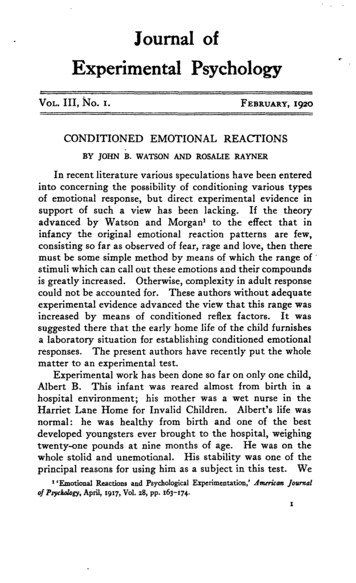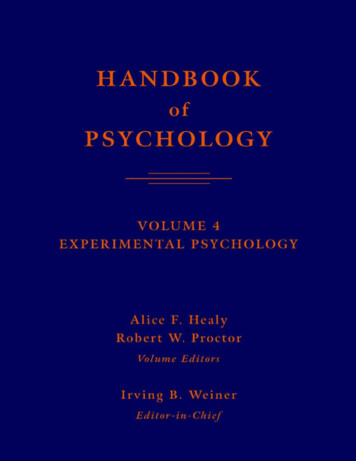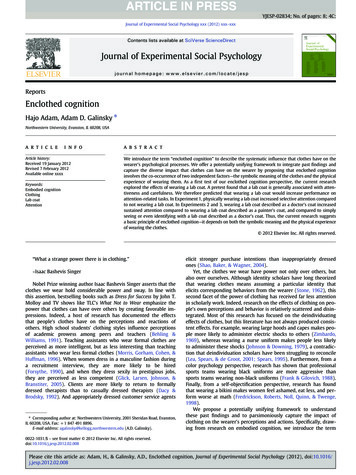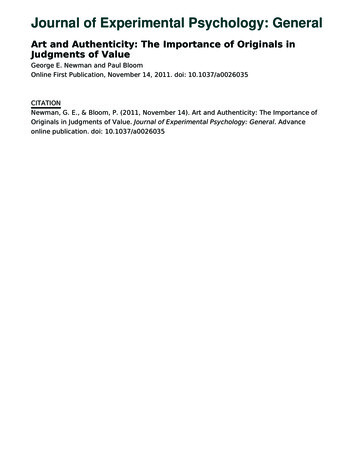
Transcription
Journal of Experimental Psychology: GeneralArt and Authenticity: The Importance of Originals inJudgments of ValueGeorge E. Newman and Paul BloomOnline First Publication, November 14, 2011. doi: 10.1037/a0026035CITATIONNewman, G. E., & Bloom, P. (2011, November 14). Art and Authenticity: The Importance ofOriginals in Judgments of Value. Journal of Experimental Psychology: General. Advanceonline publication. doi: 10.1037/a0026035
Journal of Experimental Psychology: General2011, Vol. , No. , 000 – 000 2011 American Psychological Association0096-3445/11/ 12.00 DOI: 10.1037/a0026035Art and Authenticity: The Importance of Originals in Judgments of ValueGeorge E. Newman and Paul BloomYale UniversityWhy are original artworks valued more than identical duplicates? The present studies explore 2mechanisms underlying the special value of original artwork: the assessment of the art object as a uniquecreative act (performance) and the degree of physical contact with the original artist (contagion). Across5 experiments, participants were exposed to hypothetical scenarios in which an original object wasduplicated. The type of object varied across experiments (e.g., a painting vs. a piece of furniture) as didthe circumstances surrounding the creation of the original object and the duplicate. Overall, the resultssupport assessments of performance and contagion as key factors underlying the value of originalartwork, and they are consistent with the conclusion that the discrepancy in value between originalartworks and perfect duplicates derives from people’s lay theories about the domain of art, rather thanfrom associations with particular kinds of art or certain cases of forgery.Keywords: art, authenticity, valuation, contagionabout the domain of art, rather than from associations with particular kinds of art or certain cases of forgery.This article also examines the psychological mechanisms underlying the special value of original artworks. We identify two keydimensions that are particularly important to the valuation of originalartworks: the assessment of the art object as a unique creative act(performance) and the degree of physical contact with the originalartist (contagion). These mechanisms and their proposed role in thevaluation of art are discussed in the following sections.In May of 2000, the two major auction houses, Christie’s andSotheby’s, released their spring catalogues only to discover thatboth were selling the same painting, Paul Gaugin’s Vase de Fleurs(Lilas). The two paintings were sent to an expert who identifiedone as the real Gaugin and the other as a forgery. However, bothwere traced back to the same source, an individual named ElySakhai. As was later revealed by an FBI investigation, Sakhai hadpurchased a number of lesser known paintings by impressionistand postimpressionist artists, such as Paul Gauguin, Claude Monet,Pierre-August Renoir, and Marc Chagall. He then hired skilledforgers to copy the original paintings and would sell the duplicateswith the genuine certificate of authenticity attached. After theduplicate painting had changed hands several times, Sakhai wouldoften have the original painting re-authenticated and would sell itas well. When he was caught, Sakhai was sentenced to 4 years inprison and was ordered to pay a fine of 12.5 million (C. Thompson, 2005).Why does the origin of an artwork matter so much? Morespecifically, why are original artworks valued more than identicalduplicates? In this article, we explore the special value that peopleassign to original artwork as well as the underlying reasons for it.Across five experiments, we found that the value placed on originals is to some extent special to art—the drop in value for aduplicate artwork is more than the drop in value for a duplicate ofa nonartistic artifact. This is true even when the original artworkand the original artifact are both one of a kind, their values areequated, and the method of production is identical. Our findingssuggest, then, that the discrepancy in value between original artworks and identical duplicates derives from people’s lay theoriesHistorical Sources of ValueThe way in which one’s own personal history influences thevalue of objects is a major topic of interest within psychology (e.g.,see Keys & Schwartz, 2007, for a review). For example, ownershipmatters; even though there may be no tangible difference betweena mug that one owns and another identical mug, the owned mugtends to be more valued—the so-called endowment effect (e.g.,Kahneman, Knetsch, & Thaler, 1990; Thaler, 1980). Choice alsomatters; a classic demonstration in the cognitive dissonance literature is that an object that a person chooses becomes more valuable simply by being chosen, whereas something that is rejectedloses value (e.g., Brehm, 1956; Egan, Santos, & Bloom, 2007;Festinger, 1957). In addition, objects that play an important rolefor memory—for example, to document a special vacation withfriends—may also acquire significant value (Zauberman, Ratner,& Kim, 2008).Here we are concerned with a different though potentiallyrelated set of phenomena, in which the relevant historical properties extend outside the self. Examples of this are common ineveryday life: People have paid considerable money for a tapemeasure owned by President Kennedy, an autograph by astronautNeil Armstrong, and pop star Britney Spears’s chewed-up bubblegum (Bloom, 2004, 2010; Frazier, Gelman, Wilson, & Hood,2009; Hood & Bloom, 2008; Newman, Diesendruck, & Bloom,2011). Such objects are valued because of where they came fromand the people they came into contact with and not because of theirGeorge E. Newman, School of Management, Yale University; PaulBloom, Department of Psychology, Yale University.Correspondence concerning this article should be addressed to GeorgeE. Newman, School of Management, Yale University, 135 Prospect Street,New Haven, CT 06520. E-mail: george.newman@yale.edu1
NEWMAN AND BLOOM2tangible properties or presumed special utility. For example, if thebuyer of the tape measure discovered that it was actually not fromthe Kennedy household, he would presumably be outraged andwant his 48,875 back, though nothing perceptible or tangibleabout the object would have changed.This phenomenon is not unique to objects that have been incontact with celebrities. People value items with personal significance, such as their child’s first baby shoes or their wedding rings(see Belk, 1988) and do not replace them with duplicates, even ifthey cannot tell the difference. Unlike objects such as hand-writtenBeatles lyrics or a gown worn by Princess Diana, however, adultsare aware that the increased valuation of these personal objectsdoes not lead to greater market value or public interest. People donot believe, for instance, that their child’s baby shoes should be ina museum (Frazier et al., 2009).Developmental OriginsThere is some evidence that the valuation of certain objects overperfect duplicates emerges spontaneously in development. Manyyoung children become attached to so-called transitional objects,such as blankets or soft toys (Passman, 1987)—they hold themwhen stressed, sleep with them, and are miserable if they are lost.In a recent set of studies, Hood and Bloom (2008) exploredwhether children’s attachments are locked on to those preciseobjects or whether they would extend to perfect duplicates. Threeto 6-year-old children were shown a special machine that was saidto copy physical objects exactly. When asked to put everydayobjects, such as toys and shoes, in the machine, children were morethan willing, and when given the choice as to which one theywould like to take home, children showed a slight preference totake home the duplicate object. However, when children withtransitional objects were asked to place their object in the machine,many did not allow their attachment objects to be duplicated, andthose who did usually preferred to bring home the original.In another experiment, 6-year-old British children watched as agoblet that was said to have belonged to Queen Elizabeth wasplaced into the duplication machine. Children were then asked howmuch the original goblet and duplicate goblet should be worth.Many children said that the original was worth more than theduplicate—a pattern that did not ensue when the duplicated objectwas a goblet that was not owned by someone special (Hood &Bloom, 2008). These results suggest that for at least some types ofobjects, even young children may place a special value on originalsas compared with perfect duplicates.History and the Value of ArtThe focus of this current article is the domain of artwork, whichprovides perhaps the strongest example of the importance ofhistory. For example, when The Disciples at Emmaus was discovered to have been painted, not by Vermeer, but by the masterforger Van Meegeren, it went from being one of the most valuablepaintings in Holland to a near worthless curiosity. None of thepainting’s perceptible properties had changed, merely beliefs aboutthe object’s history (for discussion, see Bloom, 2010; Dutton,2003).The role of history is also salient in many cases of contemporaryart. In several instances, artists have presented relatively ordinaryobjects, such as a urinal (Marcel Duchamp), a white canvas (Robert Rauschenberg), vacuum cleaners (Jeff Koons), and a pile ofbroken glass (Robert Smithson), as works of art. These particularobjects are valued at millions of dollars, whereas physically indiscernible displays that did not come into contact with the artist (e.g.,an identical commercial vacuum cleaner) are of no aesthetic interest and are worth substantially less (Bloom, 2004, 2010; Dutton,2009; D. Thompson, 2008).Why are assessments of history relevant to the valuation ofartwork? We consider three potential explanations.Assessments of PerformanceDutton (2003, 2009) has argued that people assess artwork, evenstatic artwork such as paintings, as the end point of performances.From this perspective, our assessment of an artwork is related toour intuitions about the processes that gave rise to its existence.Thus, an original is different from a forgery because it is the endpoint of a different sort of performance. The original is a creativework, whereas the forgery is not. Similarly, people assess anartwork differently if was done by someone in the 19th centuryversus someone in the 21st century, by an experienced artist versusan outsider, or by an adult versus a child.This proposal is supported by experiments that manipulate thecircumstances under which an artwork has come into being. Forexample, Kruger, Wirtz, Van Boven, and Altermatt (2004) foundthat participants believe that a painting that took longer to paint isaesthetically superior and worth more money than one that waspainted quickly, even though the two paintings are perceptuallyidentical (also see Cho & Schwarz, 2008). From this perspective,art is much like any sort of performance, including music andsport. History matters for all of these domains. People carewhether such performances are the result of practice versus innateskill and whether they are natural or artificially enhanced (e.g.,Riis, Simmons, & Goodwin, 2008).ContagionAnother explanation is rooted in the law of contagion (Frazer,1890/1959; Mauss, 1902/1972; Newman et al., 2011; Rozin &Nemeroff, 2002; Tylor, 1897/1974). This is the belief that, throughphysical contact, objects can take on a special quality or essence.For example, people are reluctant to purchase a T-shirt if it wasjust tried on by a stranger (Argo, Dahl, & Morales, 2006). However, they are more likely to purchase a T-shirt if it was recentlyworn by someone attractive (Argo, Dahl, & Morales, 2008). Similarly, the possessions of celebrities, such as President BarackObama or George Clooney, lose value if their physical contactwith the celebrity is undermined, as when the object is sterilized(Nemeroff & Rozin, 1994; Newman et al., 2011).This account extends naturally to art. An original Picasso maybe valuable because Picasso actually touched it, and Picasso is afamous and well-known artist. In contrast, a forgery would nothave been touched by Picasso and, therefore, would not containany of his special essence. Such contagion effects are not limitedto art; they extend as well to objects such as autographs, babyshoes, and the possessions of celebrities (e.g., Newman et al.,2011).
ART AND AUTHENTICITYIntuitions About Market ValueA final explanation is that original artworks are valued becauseof intuitions about their market value— how much others will payfor them.1There are different versions of this claim. The simplest is thatpeople associate originals with increased value. Typically, weoften use the term original to refer to valued objects, and so peoplemight assume that items that have the term applied to themare likely to be more valuable than other objects. For example,people may think that an original widget should be more valuablethan a duplicate widget. This account, however, predicts no systematic difference in increased value of original artwork versusoriginal artifacts. We explored this issue in the studies describedlater by directly comparing original artworks to original nonartisticartifacts.Another version of the market value account has to do withscarcity. Original art objects are unique and thus, by definition, area scarce commodity. It is clear that scarcity matters for the valueof an artwork. For example, the more copies of a print there are,the less they are worth (Cialdini, 1985). Further, when an artistdies, the value of his or her creations often rises, most likelybecause there are not going to be any more of them. As with theversion of this claim described earlier, this account predicts nodifference between artwork and artifacts, because an original artwork is going to be just as scarce as an original artifact.One limitation of this scarcity proposal is that it doesn’t explainwhy a unique painting may decrease significantly in value depending on beliefs about its history. For example, in the case of TheDisciples at Emmaus, why is a painting believed to be a (one-ofa-kind) Vermeer worth far more than a painting believed to be a(one-of-a-kind) Van Meegeren?Perhaps the answer is that people know that other people willpay more for the Vermeer than for the Van Meegeren. It iscommon knowledge, after all, that original artworks are morevaluable than duplicates. People might, therefore, give more valueto original artwork simply because they have observed this factabout the world; they are aware that, for whatever reason, peoplepay more for original artwork. As an analogy, a person might valuegold more than silver just because he or she knows that othersvalue gold more than silver, without having any theory of whygold would be worth more.We see this as the most plausible version of the market valueaccount. Note, however, that this theory just pushes the questionback, as it does not explain why these other people would valueoriginal artwork. In other words, the observation that there is amarket for original artwork does not explain why the phenomenonexists in the first place. More importantly, however, this proposalcan be readily distinguished from the performance and contagionaccounts presented earlier. The market value account predicts thatthe key factor to determining the value of an original artwork(relative to a duplicate) is its status as an original artwork. Thus,unlike the competing theories, contagion and performance, itmakes no predictions about people’s sensitivity to subtle factsabout an artwork’s history when they assess its value.Is Art Special?The factors just discussed are not unique to art. Of course,intuitions about market forces apply to the valuation of all con-3sumer products. As noted earlier, beliefs about physical contagioncan influence the value of clothing (Argo, Dahl, & Morales, 2008)and celebrity items (Newman et al., 2011), and beliefs about thehistory of creation likely underlie all sorts of consumer preferences. For example, in The Theory of the Leisure Class, ThorsteinVeblen (1889/2007) observed that a hand-wrought silver spoonmight be indistinguishable from one made by a machine but is farmore valuable.We suggest, however, that considerations of performance andcontagion are particularly relevant for artwork. One reason for thishypothesis is that other human-made creations have functions andare valued, at least in part, on how well they fulfill them.2 Spoonshelp us drink liquids, clothes cover our bodies, and so on. Thesefunctions are why these artifacts exist in the first place and are animportant consideration in why people possess them. However, arthas no function of this sort. In the absence of utility, considerationssuch as contagion and performance become correspondingly moreimportant (Hagtvedt & Patrick, 2008). To put it differently, thesefactors become more relevant for artwork simply because otherfactors do not apply.This is a negative account, focusing on what artworks lack.However, there is a corresponding positive explanation: The pleasure that people get from artwork might specifically draw onconsiderations of performance and personal contact. Under someaccounts (Bloom, 2010; Dutton, 2009; Miller, 2000), the mainreason people are drawn to works such as paintings is an instinctive interest in the creativity and skill of other individuals, possiblyevolved as a way to assess them as friends, allies, or mates. Thissuggests that the specific history of creation should be particularlyrelevant for this domain.Overview of StudiesThe current experiments explored these issues by asking layparticipants (i.e., individuals without expertise in art) for theirestimations of an artwork’s value. Obviously, there are manydomains for which perceptions of value are dependent on one’sexpertise. For example, Buffalo-head nickels may range in valuefrom a few cents to thousands of dollars, though what distinguishesone nickel from the next is clearly a matter of prior knowledge(Weaver & Frederick, 2009). We hypothesized, however, thatunlike rare coins or stamps, even people who lack formal trainingabout art possess fairly specific and reliable intuitions about artand what makes art objects valuable.Experiment 1 provided an initial empirical demonstration that,controlling for the value of the originals, duplicate artworks arejudged to be less valuable than duplicate artifacts. Experiment 2replicated this pattern while controlling for a number of additionalfactors that are typically confounded across the domains of artworks and artifacts, including the scarcity of the original objects,inferences about the quality of the duplicates, and the belief thatduplicate artifacts are simply more common than duplicate artworks. Experiment 3 looked at artworks specifically and tested an1We thank an anonymous reviewer for extended discussion on thispoint.2We thank Henrik Hagtvedt for raising this issue; the discussion of thisissue is partially based on his comments.
NEWMAN AND BLOOM4alternative explanation that original artworks are valued morebecause they take more time, effort, and money to produce compared with identical duplicates. Experiments 4 and 5 tested the twokey principles that were hypothesized to be important to thevaluation of original artworks: the assessment of the art object asa unique creative act (performance) and the degree of physicalcontact with the original artist (contagion).Experiment 1MethodThirty-three undergraduates read stories about either paintingsor automobiles. Stimuli were presented in a 2 2 mixed-modeldesign. Between subjects, we manipulated the domain of theobjects (art vs. artifact). Within subjects, we manipulated whetherthe duplicate was created by the original manufacturer or bysomeone else. The stimuli presented to participants were as follows:Art, original manufacturer: The Mill, a painting by a well-knownartist named Roberts, is currently stored in Warehouse A. The painting is valued at 100,000. The artist agrees to make an exact duplicatepersonally. The duplicate is identical in every way. The duplicate isstored in Warehouse B.Art, different manufacturer: Murder of Valentinian, a painting by awell-known artist named Smith, is currently stored in Warehouse A.The painting is valued at 100,000. The artist agrees to have anapprentice create an exact duplicate. The duplicate is identical inevery way. The duplicate is stored in Warehouse B.Artifact, same manufacturer: R-TL, a prototype car by a well-knownmanufacturer named Roberts, is currently stored in Warehouse A. Theautomobile is valued at 100,000. The manufacturer agrees to makean exact duplicate. The duplicate is identical in every way. Theduplicate is stored in Warehouse B.Artifact, different manufacturer: RI-XP, a prototype car by a wellknown manufacturer named Smith, is currently stored in WarehouseA. The automobile is valued at 100,000. The manufacturer agrees tohave a subcontractor make an exact duplicate. The duplicate is identical in every way. The duplicate is stored in Warehouse B.After reading each story, participants rated how much the duplicate painting (or car) was worth, using a 9-point scale (0 a lotless than 100,000, 8 a lot more than 100,000).We predicted that, overall, duplicate artworks should be seen asless valuable than duplicate artifacts. We also predicted that participants would judge artworks made by the original artist to bemore valuable than artworks made by the assistant, because of thevalue added by personal contact. Thus, we predicted an interactionbetween the domain of the object (art vs. artifact) and whether theduplicate was made by the original manufacturer versus someoneelse.Results and DiscussionResults from this study are depicted in Figure 1. We conducteda mixed-model analysis of variance (ANOVA) with domain (artvs. artifact) as a between-subjects variable and contagion (samemanufacturer vs. different manufacturer) as a within-subjects vari-Figure 1. Results from Experiment 1. Comparison of the average valuerating of the duplicate artwork or artifact ( SE) where 4 represented thesame value as the original.able. This analysis revealed a main effect of domain. As predicted,duplicate artworks were overall seen as significantly less valuable(M 1.92, SD 1.12) than duplicate artifacts (M 3.46, SD 1.19), F(1, 31) 15.31, p .001.In addition to the predicted main effect of domain, we alsoobserved a significant Domain Contagion interaction, F(1,31) 7.66, p .01. Duplicate works of art made by the sameartist were judged as significantly more valuable (M 3.00, SD 1.89) than duplicate works of art made by the assistant (M 0.84,SD 1.39), t(18) 4.19, p .001. In contrast, the differencebetween duplicate automobiles made by the original manufacturerversus those made by a subcontractor was not statistically significant (Ms 3.64 and 3.29, respectively).Finally, we compared each of the four cells against the midpointof 4 (i.e., the same value as the original). Consistent with theanalyses described earlier, we observed that the duplicate paintingwas seen as significantly less valuable than the original, both whenit was made by the same artist, t(18) 2.31, p .05, and whenit was made by the assistant, t(18) 9.94, p .001. In contrast,both scenarios involving a duplicate automobile were not judged tobe significantly less valuable than the original.Thus, results from this initial study were consistent with thehypothesis that the concept of an original plays a special role inpeople’s reasoning about artworks. Participants judged a duplicateartwork to be significantly less valuable than a duplicate of anonartistic artifact. As predicted, we also found that whether theduplicate was made by the same manufacturer or by someone elsemattered more for artworks than for artifacts, which is consistentwith the notion that contact with the original artist (contagion) mayplay a special role in the valuation of art.Experiment 2The previous study suggests that lay participants have uniqueintuitions about the domain of art. This includes the belief thatduplicate artworks are worth less than duplicate artifacts as well asmore auxiliary assumptions about the importance of contact withthe same artist. One concern, however, was that these differencescould have resulted from people’s familiarity with the categoriesof objects that were chosen. People may (correctly) believe thatpaintings tend to be one-of-a-kind items, whereas automobiles tendto be mass produced. This could, in turn, explain why people value
ART AND AUTHENTICITYduplicate artworks less than duplicate artifacts. For example, theduplicate painting is less valuable because it is unfamiliar, whereasthe duplicate automobile is expected.To address this concern, we made two changes in the design.First, we explicitly told participants that the original artwork andthe original artifact were each one-of-a-kind items. Second, wedevised a scenario in which familiarity alone could not driveexpectations about the value of duplicates. Previous theoreticalwork (Bloom, 2004; Danto, 1981) has suggested that in certaincases, an artist may “baptize’” an object such that an ordinaryartifact becomes art merely through the artist’s intent for it to beviewed as such (e.g., Marcel Duchamp’s urinal, or Jeff Koons’svacuum cleaners).In the present study, we capitalized on this type of example andexamined cases in which an ordinary artifact (a chair) was intended to be either a piece of art or a piece of furniture. Thisallowed us to manipulate the superordinate category of the object(art vs. nonartistic artifact), while holding all other dimensions,especially familiarity with the basic-level category (e.g., paintingvs. automobile), constant. We predicted that lay participants wouldbe sensitive to this manipulation of the artist’s intentions andwould judge a duplicate artwork to be less valuable than theduplicate artifact, even though the same object (a chair) wasdescribed throughout.In this study, we also stated that the original object was destroyed and replaced with a duplicate. This too provides a strictertest of the hypothesis that originals are more important to thedomain of art because in all cases there were no competitors to theoriginal object (see Rips, Blok, & Newman, 2006). For example,in cases where the original exists, one might expect duplicates tobe less valued simply for scarcity reasons. However, if the originalhas been destroyed, an account based solely on intuitions abouteconomic value cannot explain the effect.Additionally, in the previous study, we manipulated whether theduplicate object was created by the original manufacturer or bysomeone else and observed that this dimension mattered more forartworks than for artifacts. It may be, however, that these judgments were confounded with inferences about the quality of theduplicate. Therefore, we devised a new scenario in which themanufacturer of the duplicate and the circumstances surroundingits creation were held constant throughout all conditions.Finally, to test the role of the artist’s intentions per se, participants read that once the item was purchased, the owner used theobject either like a piece of art or like an artifact (either congruentwith or the opposite of the manufacturer’s intentions, depending oncondition). These factors were crossed in a 2 2 design so that wewere able to directly compare the relative importance of theoriginal manufacturer’s intentions (for the object to be viewed asart vs. an artifact) versus the importance of how the object wasused once purchased.5subjects, we varied whether the chair was intended to be art(something that was purely for display) or an artifact (a piece offurniture). The chair was then sold for 1,000 to a private party,who used the object either in the way that was intended (i.e., as artor as furniture, depending on condition) or in a manner opposite towhat was intended. Participants then read that the original wasaccidentally destroyed and was replaced with an identical duplicate that was manufactured by someone else. The specific wordingof the scenario was as follows (with slightly different wordingsdepending on condition):A skilled craftsman named Smith decided to make a chair. The chairwas an original design and one of a kind, and he intended it to be apiece of (art—something that people would display in their homes, butnever actually sit in/furniture—something that people would actuallysit in, not just display in their homes).Smith sold the chair to a family for 1,000. (However, unlike Smithwanted, the family did not treat the chair as art and, instead, they satin it all the time./Like Smith wanted, the family treated the chair as artand never sat in it.)One day, the family’s young son was playing on the chair and brokeit. The chair couldn’t be repaired and the family liked it very much, sothey hired a new craftsman that was not Smith to build an identicalcopy as a replacement. The craftsman made a new chair using theexact same kind of materials that Smith had. When it was finished itsappearance was identical to the original.After reading each story, participants rated how much the replacement chair was worth compared with the original, using ascale from 1 to 9 (1 a lot less than 1,000, 5 about 1,000,and 9 a lot more than 1,000). Then, participants completed aforced-choice item responding to the question, “In your opinion, isthe replacement chair worth less than the original, more than theoriginal, or about the same?”ResultsResults from this study are depicted in Figure 2. We examinedthe ratings of the duplicate’s value through a 2 2 ANOVA withintention (art vs. artifact) and use (art vs. artifact) as betweensubjects variables. As predicted, when the original object wasintended to be art, the duplicate was seen as significantly lessMethodParticipants and procedure.We recruited 115 ad
Journal of Experimental Psychology: General Art and Authenticity: The Importance of Originals in Judgments of Value George E. Newman and Paul Bloom Online First Publication, November 14, 2011. doi: 10.1037/a0026035 CITATION Newman, G. E., & Bloom, P. (2011, November 14). Art and Authenticity: The Importance of Originals in Judgments of Value.




